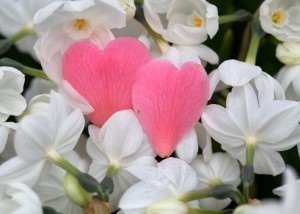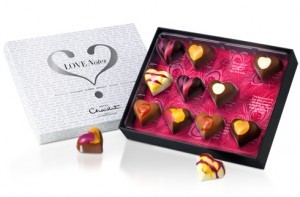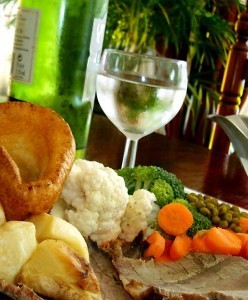Hannah Fielding's Blog, page 136
February 13, 2013
Five facts you may not know about Valentine’s Day
We all know that Valentine’s Day is a day for showing the person you love just how you feel. But how much do you know about the history of the day? Here’s a handful of facts you can use to impress your partner over a romantic meal this Valentine’s:
According to Catholic recordings, there have been ten Saint Valentines in history. But the one generally agreed to be the Valentine whom we celebrated on February 14th was a Roman priest who lived in the third century. That Valentine is the patron saint of love and lovers… but also, strangely, epilepsy and bee keepers.
Saint Valentine’s Day has its origins in the Roman fertility festival called Lupercalia, which was celebrated between February 13th and 15th. It was a cleansing ritual to purify the city and invite health and fertility. One of the core elements of the festival was the whipping of women and young girls, which was meant to help fertility.
The phrase ‘wear one’s heart on one’s sleeve’ has its origins in Valentine’s Day custom. In the Middle Ages your Valentine was determined by the name you pulled from a bowl containing all the names of eligible young men/women in the area. You would wear the name on your sleeve for the week.
The celebration of Valentine’s Day first became connected to romance in the 14th century when courtly love developed around Chaucer’s poetry. In his ‘Parliament of Fowls’ he described birds coming to meet atop a hill to choose mates for the spring: ‘That has shaken off winter’s storms/And driven away the long night’s black!/Saint Valentine, that are full high aloft,/Thus sing small birds for thy sake…’
The tradition of giving ‘sweets to your sweet’ is an old one; but from where did the phrase originate? In fact, the line is from Shakespeare’s Hamlet (Act 5, Scene 1), and is said by the queen as she scatters flowers for poor Ophelia, who has killed herself out of love-induced madness.
February 12, 2013
The romantic sweep of a staircase
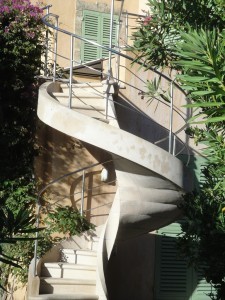 The stairs from the garden to the first floor at our home in France. I love their sculptural elegance.
The stairs from the garden to the first floor at our home in France. I love their sculptural elegance.
February 11, 2013
What is your favourite love poem?
In days of old, reading poetry to a beau was the central part of courting. Sadly, those days have passed – but Valentine’s Day is the one day of the year when we can hark back to that older, highly romantic era, and show our love for a partner through the medium of poetry.
Here, I offer snippets of some of my favourite love poems to include in a card, or whisper soulfully in the moment. Which speak to you? Which would you add to the list? I would love to hear your thoughts.
To My Dear and Loving Husband by Anne Bradstreet
If ever two were one, then surely we.
If ever man were lov’d by wife, then thee;
If ever wife was happy in a man,
Compare with me ye women if you can.
I prize thy love more then whole Mines of gold,
Or all the riches that the East doth hold.
My love is such that Rivers cannot quench,
Nor ought but love from thee, give recompence.
Thy love is such I can no way repay,
The heavens reward thee manifold I pray.
Then while we live, in love let’s so persever,
That when we live no more, we may live ever.
Love’s Philosophy by Percy Bysshe Shelley
The fountains mingle with the river
And the rivers with the ocean,
The winds of Heaven mix forever
With a sweet emotion;
Nothing in the world is single;
All things by a law divine
In one spirit meet and mingle.
Why not I with thine? -
See the mountains kiss high Heaven
And the waves clasp one another;
No sister-flower would be forgiven
If it disdained its brother;
And the sunlight clasps the earth
And the moonbeams kiss the sea:
What is all this sweet work worth
If thou kiss not me?
i carry your heart with me by e.e. cummings
i carry your heart with me(i carry it in
my heart)i am never without it(anywhere
i go you go,my dear; and whatever is done
by only me is your doing,my darling)
i fear
no fate(for you are my fate,my sweet)i want
no world(for beautiful you are my world,my true)
and it’s you are whatever a moon has always meant
and whatever a sun will always sing is you
here is the deepest secret nobody knows
(here is the root of the root and the bud of the bud
and the sky of the sky of a tree called life;which grows
higher than the soul can hope or mind can hide)
and this is the wonder that’s keeping the stars apart
i carry your heart(i carry it in my heart)
Sonnets from the Portuguese XIV by Elizabeth Barrett Browning
If thou must love me, let it be for nought
Except for love’s sake only. Do not say
‘I love her for her smile–her look–her way
Of speaking gently,–for a trick of thought
That falls in well with mine, and certes brought
A sense of pleasant ease on such a day’–
For these things in themselves, Beloved, may
Be changed, or change for thee,–and love, so wrought,
May be unwrought so. Neither love me for
Thine own dear pity’s wiping my cheeks dry,–
A creature might forget to weep, who bore
Thy comfort long, and lose thy love thereby !
But love me for love’s sake, that evermore
Thou mayst love on, through love’s eternity.
Love by Samuel Taylor Coleridge
And in Life’s noisiest hour,
There whispers still the ceaseless Love of Thee,
The heart’s Self-solace and soliloquy.
You mould my Hopes, you fashion me within ;
And to the leading Love-throb in the Heart
Thro’ all my Being, thro’ my pulse’s beat ;
You lie in all my many Thoughts, like Light,
Like the fair light of Dawn, or summer Eve
On rippling Stream, or cloud-reflecting Lake.
And looking to the Heaven, that bends above you,
How oft! I bless the Lot that made me love
Sonnet 18 by Shakespeare
Shall I compare thee to a summer’s day?
Thou art more lovely and more temperate:
Rough winds do shake the darling buds of May,
And summer’s lease hath all too short a date:
Sometime too hot the eye of heaven shines,
And often is his gold complexion dimm’d;
And every fair from fair sometime declines,
By chance or nature’s changing course untrimm’d;
But thy eternal summer shall not fade
Nor lose possession of that fair thou owest;
Nor shall Death brag thou wander’st in his shade,
When in eternal lines to time thou growest:
So long as men can breathe or eyes can see,
So long lives this and this gives life to thee.
February 9, 2013
Interview with Elizabeth McKenna, historical romance novelist
 Elizabeth McKenna is a full-time technical writer/editor for a large software company. She never read romance novels until one Christmas when her sister gave her the latest bestseller by Nora Roberts. She was hooked from page one (actually, she admits it was the first love scene).
Elizabeth McKenna is a full-time technical writer/editor for a large software company. She never read romance novels until one Christmas when her sister gave her the latest bestseller by Nora Roberts. She was hooked from page one (actually, she admits it was the first love scene).
She had always wanted to write fiction, so when a psychic told her she would write a book, Elizabeth felt obligated to give it a try. She combined her love of history, romance and a happy ending to write her first novel Cera’s Place. She recently released a short story titled The Gypsy Casts a Spell.
Elizabeth lives in Wisconsin (Packers, Brewers, and Badgers – oh my!) with her understanding husband, two beautiful daughters, and sassy Labrador. When she isn’t writing, working, or being a mom, she’s sleeping.
Welcome to the blog. Can you tell us a little about yourself?
I’m a technical writer for a large software company. I’m married to a wonderful man and have two teenage girls and an extremely sassy yellow lab.
What made you want to become a writer?
Honestly, writing comes easier than anything else I’ve tried. Since I was a little girl, I have told stories to myself in my head. In high school, I did get strong grades in math and science, which made my father push me to be an engineer. However, in college, English class was much easier than Physics – and I could still go out at night – so I switched.
Who are your favourite writers?
J.K. Rowling would be at the top of that list along with Suzanne Collins. I’ve read most of Stephen King’s books. In the romance genre, I went on a huge Nora Robert’s kick a few years back.
Why do you choose romance as the genre within which you write?
I need a happy ending and I like history, so it made sense to me to pick historical romance as my genre.
What’s the most rewarding element of writing for you?
I think the most rewarding thing is connecting with people. I am shy by nature, but I’ve met so many people (readers and authors) over the internet since I started writing. It’s been fun.
What’s the most challenging element of writing for you?
Definitely finding the time to write. I wish I could quit my day job or win the lottery(!).
At what point did you think, ‘I’ve done it – I’ve become a writer’?
I’m not sure I’m there yet! I struggle with self-doubts on a daily basis. However, I went into fiction writing with the attitude that if I sold one book to a stranger (because relatives don’t count), I’d be happy. I’ve sold more than that, so I guess I should consider myself a writer.
Can you share a little about your writing process?
When I write a story, I start with the setting, research the history of the place, and then build the plots and characters from there.
What’s your most recent book about?
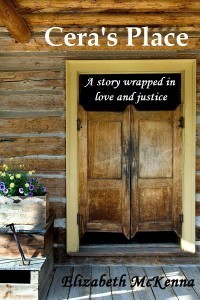 My debut novel, Cera’s Place, is set in San Francisco 1869. Cera runs a saloon but, unlike other such businesses of the times, she doesn’t allow prostitution. Over the years, she has helped women escape their terrible lives and become “respectable.” Jake is an ex-soldier haunted by his Civil War experiences. He’s on a mission to find the daughter of a friend who died in battle. One of the subplots of the novel is based on actual events. During this time period, since the majority of the Chinese population in California was male, Asian women were kidnapped and forced into prostitution in America. The Anti-Prostitution Act of 1870 made it illegal to import women for criminal or demoralizing purposes. Cera and Jake team up to fight a gang that is kidnapping Chinese girls for the local brothels. Of course, in the process they fall in love.
My debut novel, Cera’s Place, is set in San Francisco 1869. Cera runs a saloon but, unlike other such businesses of the times, she doesn’t allow prostitution. Over the years, she has helped women escape their terrible lives and become “respectable.” Jake is an ex-soldier haunted by his Civil War experiences. He’s on a mission to find the daughter of a friend who died in battle. One of the subplots of the novel is based on actual events. During this time period, since the majority of the Chinese population in California was male, Asian women were kidnapped and forced into prostitution in America. The Anti-Prostitution Act of 1870 made it illegal to import women for criminal or demoralizing purposes. Cera and Jake team up to fight a gang that is kidnapping Chinese girls for the local brothels. Of course, in the process they fall in love.
What inspired you to write this book?
Several years ago, my children were studying different careers at school. They asked me if I liked my job and I said I would rather be writing fiction. They asked why I didn’t do that then. Instead of explaining about bills and mortgages, I started writing romance in my spare time. I felt it was important to show them that it was never too late to follow your dreams.
When I starting writing Cera’s Place, I read about the history of California and picked San Francisco because of the turmoil going on there – things were ruthless as the city grew. I wanted my heroine to be strong. There weren’t many jobs for women, but I read about a few saloon owners and how tough the women had to be to survive, so Cera became a saloon owner. I wanted my hero to be a rugged cowboy somewhere in the West but in the end, he became a soldier to honor the service people who find it hard to go back to a normal life after serving in a war.
How did you decide upon the title?
I struggled with the title, but to Cera, the saloon was her home and a place of safety for others. She was willing to fight for it and to fight for others, whether they were prostitutes or kidnapped Chinese girls. I thought Cera’s Place – the name of her saloon – just encompassed it all.
What message would you most like readers to take away from the book?
One message would be that it is ok to let others help you. Cera tries to do everything by herself and that doesn’t always work. She needed to learn that it was ok to accept Jake’s help – and ultimately his love.
If a movie was made of your book, which actors would you cast in the leading roles?
Jake has always been Viggo Mortensen in my mind. Cera is tougher to cast. I think it would be Amy Adams as she was in The Fighter (not Enchanted).
When you’re not writing, what do you most like to do?
Sleep. I can’t get enough.
What, for you, is the very epitome of a romantic moment?
When a man takes a woman’s face in his hands, looks into her eyes, and then gently kisses her lips. It could also be when he cooks dinner AND cleans up afterwards!
What’s next in your writing career?
I’m working on another historical romance, Venice in the Moonlight, set in 1753 during Casanova’s time. It is a story of vengeance, forgiveness, and love and should be available later this year. Here is the description:
After her husband’s death, Marietta Gatti is banished from the family’s villa by her spiteful mother-in-law. With nowhere to go, she returns to Venice and her only kin – a father she hasn’t spoken to since her forced marriage.
Hoping to make amends, she is devastated to find he has died two months earlier. When his lover insists it was under suspicious circumstances, Marietta retraces her father’s last days only to learn someone may have wanted him dead.
When the prime suspect is the father of the man she is falling in love with, Marietta faces a heart-breaking decision. Should she risk her future happiness to avenge the death of a man she has despised for the past five years?
To find out more about Elizabeth’s books, visit http://elizabethmckenna.com/buy/ . You can also find her on Facebook at https://www.facebook.com/ElizabethMcKennaAuthor and https://www.facebook.com/CerasPlace , and on Twitter at @elizamckenna.
February 8, 2013
Book review: The Little Women Letters by Gabrielle Donnelly
From the blurb:
The Little Women Letters explores the imagined lives of Jo March’s descendants—three sisters who are both thoroughly modern and thoroughly March. As uplifting and essential as Louisa May Alcott’s Little Women, Gabrielle Donnelly’s novel will speak to anyone who’s ever fought with a sister, fallen in love with a fabulous pair of shoes, or wondered what on earth life had in store for her.
With her older sister, Emma, planning a wedding and her younger sister, Sophie, preparing to launch a career on the London stage, Lulu can’t help but feel like the failure of the Atwater family. Lulu loves her sisters dearly and wants nothing but the best for them, but she finds herself stuck in a rut, working dead-end jobs with no romantic prospects in sight. When her mother asks her to find a cache of old family recipes in the attic of her childhood home, Lulu stumbles across a collection of letters written by her great-great-grandmother Josephine March. In her letters, Jo writes in detail about every aspect of her life: her older sister, Meg’s, new home and family; her younger sister Amy’s many admirers; Beth’s illness and the family’s shared grief over losing her too soon; and the butterflies she feels when she meets a handsome young German. As Lulu delves deeper into the lives and secrets of the March sisters, she finds solace and guidance, but can the words of her great-great-grandmother help Lulu find a place for herself in a world so different from the one Jo knew?
Some things, of course, remain unchanged: the stories and jokes that form a family’s history, the laughter over tea in the afternoon, the desire to do the right thing in spite of obstacles. And above all, of course, the fierce, undying, and often infuriating bond of sisterhood that links the Atwater women every bit as firmly as it did the March sisters all those years ago. Both a loving tribute to Little Women and a wonderful contemporary family story, The Little Women Letters is a heartwarming, funny, and wise novel for today.
I picked up this novel chiefly for its connection to Little Women, a book I remember fondly from childhood, and was delighted to find that I thoroughly enjoyed it.
The characters are colourful and vivid, especially the three sisters – although I found myself most warming to the mother and father, who have a most endearing and inspiring approach to marriage. The family depicted feels real, and I found myself rooting for each member to find an answer to his/her concern. This is a book in which the author clearly thinks carefully about realism, and she handles character development in a mature way that leads to well-rounded, touching characters.
My favourite element of the book is the letters from Jo March that are interspersed with the present-day action. I found myself wanting to re-read the Little Women series afterwards, to see how the letters cleverly tied in. I think the author has done a wonderful job of matching tone and style to Louisa May Alcott’s – no easy task! – and the resultant juxtaposition of the formal, flowing, poetic style of the letters with the modern, jovial style of the present-day description is striking, and makes for interesting, engaging reading.
But for me, what is most powerful in the inclusion of the letters is the bringing together of two different worlds – nineteenth-century American, and twenty-first-century England. I remember reading Little Women as a child and getting a strong sense of the moral lessons imparted, and also being struck by the gentility of the romance back then. Set against the modern sisters’ difficulties in love and careers, the letters provide food for thought as to how society has changed. Jo was always my favourite character in Little Women, and to have her words reach across the decades to comfort and guide her great-great-granddaughter creates a fascinating connection between then and now, allowing the author to explore just what it means to be a woman forging her own path in the world, and finding the love that will last.
This is a book that stands out in the women’s literature genre. It is romance, but it is romance with so much more to offer, with a guaranteed feel-good-factor. It is a must-read for any reader who remembers Little Women fondly – and for those who love books about sisterhood and romance.
The Little Women Diaries is available now from Amazon; click on the book cover below to visit the store.
February 7, 2013
Valentine’s giveaway: Win a box of fancy chocolates and a romance novel
Happy Valentine’s Day! What better way to celebrate than sharing my passionate romance novel Burning Embers – ‘a romance like Hollywood used to make’ – and a box of chocolates from Britain’s finest chocolatier, Hotel Chocolat?
This week I’m giving away:
Top prize: 1 copy of Burning Embers plus a box of Hotel Chocolat’s to-die-for ‘Love Notes’ chocolates: irresistible chocolate hearts with melt-in-the-middle centres including champagne bellini, lemon berry tart and caramel praline.
Runners up: 4 copies of Burning Embers.
To enter, simply comment on this page telling me about your ideal Valentine’s Day. I will pick a winner on February 15th.
Good luck!
Hannah x
Category: giveaway
Longing for summer
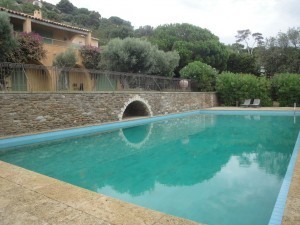 Swimming the length of our pool is part of my daily exercise when in France. It seems a long way off now that I am in wintry England!
Swimming the length of our pool is part of my daily exercise when in France. It seems a long way off now that I am in wintry England!
February 6, 2013
Love Is in the Air Giveaway Blog Hop: How to create a romantic mood this Valentine’s Day
Shop displays are a wash of pinks and reds; sound systems are booming slushy love songs; restaurants are advertising intimate dinners for two – yes, it is that time of year again: the prelude to Saint Valentine’s Day. Here’s a quick shopping list for this last week before the big day, to ensure on February 14th that you and your Valentine are misty-eyed and intimate:
Candles: Tall, small, chunky, slender, Gothic, colourful, scented – whatever your preference, arm yourself with plenty to create soft, ambient lighting.
Chocolates: Rich and velvety, gooey and decadent, melt-in-the-mouth; the very epitome of the aphrodisiac.
Music: Opt for a mix that’s slow and atmospheric.
Scent: If you’re low on your favourite perfume, or bored of it, pick up some samples and experiment with a new scent – musky and alluring? Sweet and delicate? Your partner will be weak at the knees with one breath.
5. A copy of a smouldering, tempestuous, passionate romance novel that calls to mind the Golden Age of Hollywood… Burning Embers: Just the thing to get you in the mood for love – and happily, I’m giving away a free copy…
To win a copy of Burning Embers, simply comment on this post, letting me know why you’d like to read it. I will pick a winner on 15th February. Good luck!
February 5, 2013
What would you do with an extra hour each day?
A recent survey conducted by MSN has found that most nearly four in five people could carve out an extra 1.5 hours each day. Seven thousand people responded to the survey from 13 European countries, and the results were clear: when it comes to having time to do the things you love, the personal ‘to-do’ list is the key issue. Improve your efficiency and organisation and you create valuable time for yourself.
The 1.5 hours a day equates to 10.5 hours a week, 45.5 hours a month, and 546 hours (23 days) per year. Just think what you could do with that time:
Read many, many books.
Write a book.
Write a blog.
Exercise.
Practise a skill, such as cake decorating or sculpture.
Learn a language.
Decorate your home.
Put like that, getting organised looks very attractive; you’ve much to gain. But how about making that extra hour ‘we-time’ instead of ‘me-time’? Just think how your relationship would benefit from a golden hour a day in which you and your partner make the effort to really connect with one another and be romantic. A candlelit dinner. A dance to your song. A reminiscence about how you met. A moonlit stroll on the beach. Over the course of a year, you would create a lot of intimacy and a lot of memories to look back on fondly.
Of course, though the research suggests we can create 1.5 hours a day, we know that we will struggle to do so. Still, surely ten or fifteen minutes is possible for us all? And even that shorter, focused time could make all the difference to sustaining the magical feelings that love fosters in us.
When I picture the characters I create for my novels after their happy-ever-after, I always see them as spending time together, quality time, regularly – still delighting in each other’s company and making the effort to really be present in the moment and the mood throughout their lives. For the tragedy of life is that time passes too quickly, and really each moment with a loved one is immeasurably precious.
I remember once walking along the promenade of an English seaside and seeing a very elderly couple sitting on a bench together. They were hand in hand, and gazing into each other’s eyes with an expression of pure devotion. It was one of the most romantic sights I have ever seen, and I never forgot it, or the sense it gave me that time, and how we choose to spend it, matters.
As author JR Tolkein put it, “All we have to decide is what to do with the time that is given to us.” And time is one of the integral ingredients of lasting love.
February 4, 2013
Tastes of my travels, from Egypt to Spain, Italy to France
I grew up in North Africa, and one of my favourite dishes still is called Mulukhiya – a green soup made from Mulukhiyah leaves. It’s something of a national dish in Egypt, but rather like the British yeast extract spread Marmite, you either love it or you hate it – and I love it!
Mulukhiya consists of the leaves of the Mulukhiya chopped finely and mixed with garlic and coriander, and I also like to add meat – chicken, lamb or rabbit – or shrimp. You stew the ingredients together, and then serve over rice for a filling meal.
During my international nomadic years, I travelled extensively through Europe:
In Spain, my favourite dish was Paella, spiced rice with vegetables and meat or seafood. Did you know there are three varieties: Valencian, seafood and mixed? The key ingredient is saffron, which gives the dish its signature golden colour.
In Italy, I loved Ossobucco, a dish that originates from Milan and comprises veal in a white wine and vegetable broth. Two types exist; I like the older, tomatoless version in which the flavours of bay leaf and cinnamon really complement the meat and vegetables.
In Greece, Dolma was my favourite food. It consists of a stuffing, called ‘sarma’, containing vegetables and sometimes meat, wrapped in leaves. I make it myself now, using vine leaves from my garden – delicious!
Now, I have homes in both England and France:
In France, my favourite food is Bouillabaise, a stew comprising five or six types of fish, vegetables like leeks, onions, tomatoes, celery and potatoes, and Provençal herbs and spices. For a recipe, see one of my earlier blog posts here: http://www.hannahfielding.net/?p=739.
In England, I subscribe to one of the traditions of the British cuisine: the roast dinner, usually served at a Sunday lunchtime. Roasted meat, roast potatoes, fresh vegetables and lashings of gravy – comfort food at its best, and superb, warming fuel for an afternoon’s walk in the woods or along the seashore. My favourite roast is beef, because I adore the Yorkshire puddings that accompany it. Making these batter-based delights is something of an art form, but once you master the skill, the result is delicious.
What is your favourite dish? I am always on the hunt for new dishes to try from all the world’s cuisines, so I would love to hear from you.


